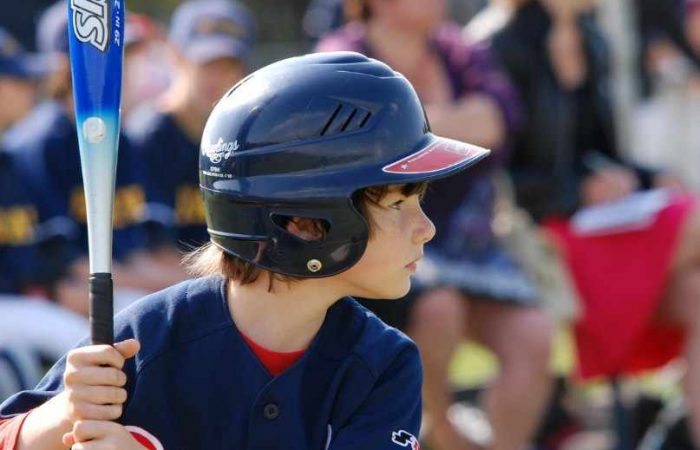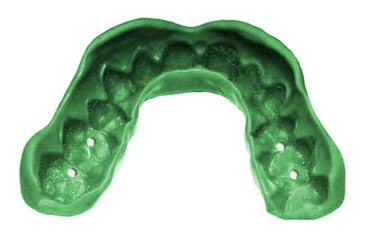Sports Mouthguards
Dental injuries are the most common type of facial injury sustained during sports participation in America. According to the National Youth Sports Foundation, more than 5 million teeth will be knocked out in sporting activities this year alone. The American Dental Association estimates that over 200,000 of these injuries are prevented each year by the use of sports mouthguards.
The lifetime dental rehabilitation costs can approach several thousand dollars per tooth for the athlete who loses a tooth (or teeth) in a sporting injury. In fact, replacing a single knocked-out tooth will cost more than 10 times the preventive cost
of a custom fitted, professional grade mouthguard.
Sports Mouthguards
Dental injuries are the most common type of facial injury sustained during sports participation in America. According to the National Youth Sports Foundation, more than 5 million teeth will be knocked out in sporting activities this year alone. The American Dental Association estimates that over 200,000 of these injuries are prevented each year by the use of sports mouthguards.
The lifetime dental rehabilitation costs can approach several thousand dollars per tooth for the athlete who loses a tooth (or teeth) in a sporting injury. In fact, replacing a single knocked-out tooth will cost more than 10 times the preventive cost of a custom fitted, professional grade mouthguard.
What Is a Mouthguard?
A mouthguard is an appliance worn in the mouth that helps prevent injuries to the teeth, lips, cheeks, tongue, and jaw. It should be worn in addition to protective headgear, which also protects against injuries to the head and neck.
If you or your child plays soccer, baseball, softball, football, volleyball, rollerblading, skateboarding, martial arts, boxing, kickboxing, roller hockey, ice hockey or lacrosse; wearing a custom fabricated mouthguard could significantly reduce the chance of dental injury.
There are three types of mouthguards from which to choose.


What Is a Mouthguard?
A mouthguard is an appliance worn in the mouth that helps prevent injuries to the teeth, lips, cheeks, tongue, and jaw. It should be worn in addition to protective headgear, which also protects against injuries to the head and neck.
If you or your child plays soccer, baseball, softball, football, volleyball, rollerblading, skateboarding, martial arts, boxing, kickboxing, roller hockey, ice hockey or lacrosse; wearing a custom fabricated mouthguard could significantly reduce the chance of dental injury.
There are three types of mouthguards from which to choose.


Stock Mouthguards
These are the least expensive type and can be bought at most sporting goods stores, ready to wear. Unfortunately, they often don’t fit very well. Although they come in several shapes and sizes, little can be done to adjust the stock mouthguard to fit your mouth. Many athletes complain that they are often too bulky, loose and uncomfortable, and usually interfere with breathing and speaking.
Boil-and-bite Mouthguards
These are also available from many sporting goods stores. They are molded to fit the mouth by boiling the mouthguard in water and then biting into the warm plastic. Boil-and-bite mouthguards provide a false sense of protection, due to the dramatic decrease in thickness created when the athlete bites the softened mouthpiece into place. And if you don’t follow the directions carefully, you can wind up with a poor-fitting mouth protector.

Stock Mouthguards
These are the least expensive type and can be bought at most sporting goods stores, ready to wear. Unfortunately, they often don’t fit very well. Although they come in several shapes and sizes, little can be done to adjust the stock mouthguard to fit your mouth. Many athletes complain that they are often too bulky, loose and uncomfortable, and usually interfere with breathing and speaking.

Boil-and-bite Mouthguards
These are also available from many sporting goods stores. They are molded to fit the mouth by boiling the mouthguard in water and then biting into the warm plastic. Boil-and-bite mouthguards provide a false sense of protection, due to the dramatic decrease in thickness created when the athlete bites the softened mouthpiece into place. And if you don’t follow the directions carefully, you can wind up with a poor-fitting mouth protector.
PlaySafe Mouthguards
This is the most highly recommended type of mouthguard. Laboratory-made PlaySafe sports mouthguards are prescribed for both professional and amateur athletes because they offer the highest level of protection during sports activity. When worn properly, they can prevent dental trauma, such as fractured teeth. They are also indicated for patients wearing orthodontic braces, who must wear a mouthguard for preventive measures.
PlaySafe sports mouthguards provide superior fit and retention compared to boil-and-bite mouthguards. Available in six levels of protection, the mouthguards range from one to three layers of laminated Ethylene-vinyl acetate (EVA) material with a final bite thickness between 3 mm and 5 mm.
PlaySafe mouthguards can be customized with stickers and team logos and are available in a variety of colors to fit the personality of every star athlete!

PlaySafe Mouthguards
This is the most highly recommended type of mouthguard. Laboratory-made PlaySafe sports mouthguards are prescribed for both professional and amateur athletes because they offer the highest level of protection during sports activity. When worn properly, they can prevent dental trauma, such as fractured teeth. They are also indicated for patients wearing orthodontic braces, who must wear a mouthguard for preventive measures.
PlaySafe sports mouthguards provide superior fit and retention compared to boil-and-bite mouthguards. Available in six levels of protection, the mouthguards range from one to three layers of laminated Ethylene-vinyl acetate (EVA) material with a final bite thickness between 3 mm and 5 mm.
PlaySafe mouthguards can be customized with stickers and team logos and are available in a variety of colors to fit the personality of every star athlete!

Six Levels of Protection
Junior: One layer of EVA material (3 mm) with added incisal and occlusal protection. Designed specifically for children with mixed dentition.
Light: Two layers of laminated EVA (3 mm) material. Designed for wrestling, volleyball, mountain biking and motocross.
Light Pro: Three layers of laminated EVA (3.5 mm) material, including one hardened layer. Specially designed to provide maximum comfort and protection for all sports.
Medium: Two layers of laminated EVA (5 mm) material. Specially fabricated for soccer, rugby, basketball, softball, rollerblading and skateboarding.
Heavy: Two layers of laminated EVA (5 mm) material with three unique power dispersion bands. Specially designed for baseball, football, racquetball, martial arts and boxing.
Heavy Pro: Three layers of laminated EVA (5 mm) material (one hardened layer). Custom fabricated for ice, field and street hockey, kickboxing, and other heavy contact sports where blows from pointed objects are expected.
Talk to Dr. Kenward or Dr. Mayoral about selecting a sports mouthguard that will provide the best protection for your athlete.

Six Levels of Protection
Junior: One layer of EVA material (3 mm) with added incisal and occlusal protection. Designed specifically for children with mixed dentition.
Light: Two layers of laminated EVA (3 mm) material. Designed for wrestling, volleyball, mountain biking and motocross.
Light Pro: Three layers of laminated EVA (3.5 mm) material, including one hardened layer. Specially designed to provide maximum comfort and protection for all sports.
Medium: Two layers of laminated EVA (5 mm) material. Specially fabricated for soccer, rugby, basketball, softball, rollerblading and skateboarding.
Heavy: Two layers of laminated EVA (5 mm) material with three unique power dispersion bands. Specially designed for baseball, football, racquetball, martial arts and boxing.
Heavy Pro: Three layers of laminated EVA (5 mm) material (one hardened layer). Custom fabricated for ice, field and street hockey, kickboxing, and other heavy contact sports where blows from pointed objects are expected.
Talk to Dr. Kenward or Dr. Mayoral about selecting a sports mouthguard that will provide the best protection for your athlete.
